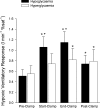The effects of hypo- and hyperglycaemia on the hypoxic ventilatory response in humans
- PMID: 17478538
- PMCID: PMC2075331
- DOI: 10.1113/jphysiol.2007.130112
The effects of hypo- and hyperglycaemia on the hypoxic ventilatory response in humans
Abstract
Animal and tissue studies have indicated that the carotid bodies are sensitive to glucose concentrations within the physiological range. This glucose sensitivity may modulate the ventilatory response to hypoxia, with hyperglycaemia suppressing the hypoxic response and hypoglycaemia stimulating it. This study was designed to determine whether hypo- and hyperglycaemia modulate the hypoxic ventilatory response in humans. In 11 normal research participants, glucose levels were clamped at 2.8 and 11.2 mmol l(-1) for 30 min. At the start and end of each clamp, blood was drawn for hormone measurement and the isocapnic hypoxic ventilatory response was measured. Because generation of reactive oxygen species may be a common pathway for the interaction between glucose and oxygen levels, the experiments were repeated with and without pretreatment for 1 week with vitamins C and E. Hypoglycaemia caused an increase in the counter-regulatory hormones, a 54% increase in isocapnic ventilation, and a 108% increase in the hypoxic ventilatory response. By contrast, hyperglycaemia resulted in small but significant increases in both ventilation and the hypoxic ventilatory response. Antioxidant vitamin pretreatment altered neither response. In conclusion, the stimulant effect of hypoglycaemia on the hypoxic ventilatory response is consistent with a direct effect on the carotid body, but an indirect effect through the activation of the counter-regulatory response cannot be excluded. The mechanisms behind the mild stimulating effect of hyperglycaemia remain to be elucidated.
Figures


 and
and  are controlled by manipulation of the inspired gas concentration. The right panel shows the ventilation versus saturation for each of the seven defined time intervals (see text) and the linear regression line.
are controlled by manipulation of the inspired gas concentration. The right panel shows the ventilation versus saturation for each of the seven defined time intervals (see text) and the linear regression line.



Comment in
-
Physiological responses to hypoglycaemia--not all 'just in the head'.J Physiol. 2007 Jul 15;582(Pt 2):475-6. doi: 10.1113/jphysiol.2007.136648. Epub 2007 Jun 21. J Physiol. 2007. PMID: 17584841 Free PMC article. No abstract available.
References
-
- Alvarez-Buylla R, Alvarez-Buylla ER. Carotid sinus receptors participate in glucose homeostasis. Respir Physiol. 1988;72:347–359. - PubMed
-
- Andronikou S, Shirahata M, Mokashi A, Lahiri S. Carotid body chemoreceptor and ventilatory responses to sustained hypoxia and hypercapnia in the cat. Respir Physiol. 1988;72:361–374. - PubMed
Publication types
MeSH terms
Substances
Grants and funding
LinkOut - more resources
Full Text Sources
Other Literature Sources
Medical

